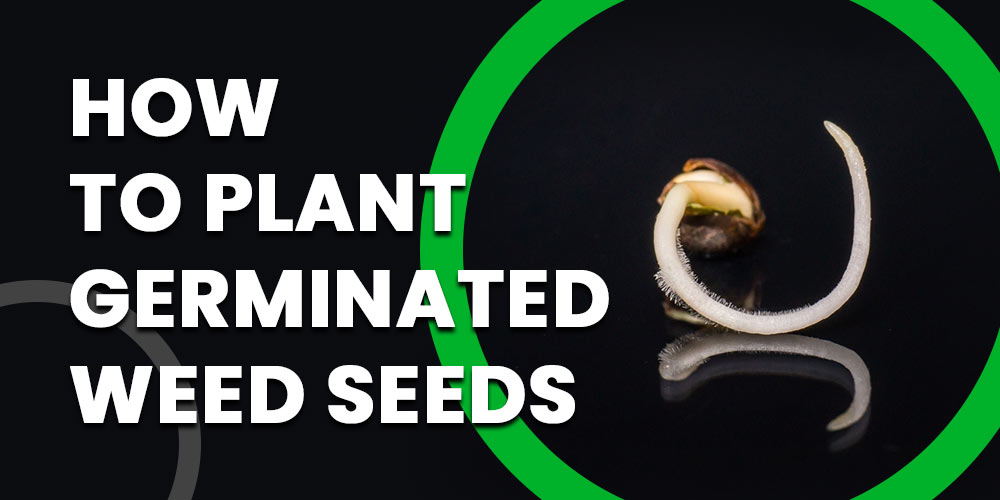



Marijuana plants that are cultivated from germinated weed seeds are known to exhibit higher yields and more uniform growth when compared to those grown from ungerminated seeds. The reason behind this phenomenon is rooted in the fact that germination signifies the readiness of the seed to sprout, thereby allowing it to absorb water and nutrients more efficiently.
To plant germinated weed seeds, you must follow a few uncomplicated steps. Firstly, you need to initiate germination by placing the seeds in water or moist soil until they sprout. Once the seeds have germinated, you can transfer them into a small container filled with moist soil or coco coir. Ensure to maintain the soil moisture at an optimum level without causing waterlogging, and provide the seedlings with ample light and ventilation.
As your seedlings progress, it becomes necessary to gradually increase their exposure to light and nutrients, ultimately leading to transplantation into more sizeable containers or into the ground. With meticulous care and attention, your germinated weed seeds will blossom into healthy, productive plants, providing you with an abundant harvest. And we will tackle more of that here in this blog.
To plant germinated weed seeds successfully, you’ll need several supplies to ensure the seeds have a healthy start and can grow into strong plants. Below is a list of necessary supplies, along with information on how to acquire them.
Germinated marijuana seeds – Acquiring marijuana seeds is possible through various means, such as procuring them from a reliable seed bank, a reputable dispensary, or a credible online source. It is significant to exercise discretion in selecting seeds of superior quality that align with your specific growing conditions, as not all strains are created equal.
Growing medium – The predominant growing surface for cultivating marijuana is soil and coco coir. These mediums can be obtained either from your neighborhood garden store or through online sources, and it is advisable to opt for premium-grade, nutrient-dense substrates that are custom-made for cannabis cultivation.
Containers – In order to accommodate your germinated weed seeds, suitable containers must be procured. Seedling trays or tiny pots can be acquired from your nearby gardening outlet or through digital channels. It is recommended to choose containers that are proportionate with the size of your seedlings and possess sufficient drainage capabilities to prevent overwatering.
Nutrients – Marijuana plants require nutrients such as nitrogen, phosphorus, and potassium to grow. You can purchase nutrients specifically formulated for cannabis plants from your local gardening store or online. Look for nutrients designed for the different stages of plant growth (e.g., vegetative, flowering).
Lighting – Proper lighting is an essential factor for the thriving growth of cannabis plants. To fulfill this requirement, grow lights can be procured from your local gardening establishment or online vendors. It is imperative to select lights that deliver the ideal spectrum and intensity of illumination that best suits the unique needs of your plants.
Ventilation – Good air circulation is important for healthy plant growth. You can purchase fans and ventilation systems from your local gardening store or online.
pH testing kit – The pH level of your growing substrate significantly influences the uptake of nutrients by your cannabis plants. To ascertain that the pH of your growing medium falls within the optimal range, pH testing kits can be acquired from your nearby gardening vendor or through digital sources. It is advisable to perform periodic pH tests to ensure that the pH level remains within the prescribed parameters.
Watering can or sprayer – Sufficient hydration is crucial for the nourishment of your cannabis plants. To provide them with the essential amount of water, a suitable watering mechanism must be procured. A watering can or sprayer can be obtained from your local horticultural outlet or through online retailers. It is essential to ensure that the chosen apparatus can disperse water uniformly and consistently to avoid overwatering or underwatering.
Creating an optimal soil environment is crucial for cultivating healthy cannabis plants. The ideal soil for this purpose should possess traits such as superior nutrient content, efficient drainage, and a pH level ranging between 6.0 and 7.0. Additionally, it should be lightweight and aerated to ensure that the roots can respire and assimilate nutrients seamlessly. Furthermore, a premium-quality soil mix should be devoid of pests and diseases that can mar the growth and development of your plants.
To prepare the soil for planting germinated weed seeds, it is vital to select a top-notch soil mix that is tailor-made for cannabis cultivation. This ensures that the soil is endowed with the right balance of nutrients to promote plant growth. Before planting, it is advisable to moisten the soil without making it waterlogged, as this can facilitate the rapid establishment of roots. Inadequate moisture levels can impede the uptake of nutrients and hinder optimal plant development.
Periodic checks of the soil pH and nutrient levels are essential to ensure that the conditions remain conducive for plant growth. pH testing kits and nutrient supplements, specifically designed for cannabis plants, can be used to monitor and adjust these levels as necessary. Additionally, incorporating organic fertilizers such as worm castings or compost can enhance soil quality and encourage the growth of beneficial microorganisms, thereby improving overall plant growth.
The proper depth for planting germinated weed seeds is approximately 1/4 to 1/2 inch deep in the soil. Planting the seeds too deeply can make it difficult for the seedlings to break through the soil surface, resulting in poor germination rates. It’s also important to space the seeds correctly to allow each plant to grow to its full potential. The ideal spacing for cannabis plants depends on the size of the plants and the growing conditions. Generally, plants should be spaced at least 18-24 inches apart to ensure that they have enough room to grow and receive adequate light and nutrients.
When handling germinated marijuana seeds during planting, it’s important to be gentle to avoid damaging the fragile roots and seedlings. Use clean hands or a sterilized tool such as a pair of tweezers to carefully transfer the seedlings into the soil. Make sure to place the seedling in the soil with the root facing downwards, and cover it with soil, being careful not to compress the soil too tightly. Water the soil immediately after planting to ensure the seedling has access to the moisture it needs to grow.
Monitoring the growth of marijuana plants is crucial for ensuring that they are healthy and growing properly. There are several ways to monitor the growth of plants, including:
Visual inspection: Regularly inspecting the plants visually can help identify any issues such as discoloration, wilting, or pests.
pH testing: Testing the pH levels of the soil or nutrient solution can help ensure that the plants are receiving the correct balance of nutrients.
Nutrient monitoring: Monitoring the nutrient levels of the soil or nutrient solution can help ensure that the plants are receiving the right amount of nutrients at each stage of growth.
Environmental monitoring: Monitoring the temperature, humidity, and lighting conditions can help ensure that the plants are growing in the optimal environment.
Common problems to look out for when growing marijuana plants include:
Pests: Common pests such as spider mites, aphids, and whiteflies can infest marijuana plants and cause damage to the leaves and buds. To address this, it’s important to regularly inspect the plants and use appropriate pest control measures such as neem oil or insecticidal soaps.
Nutrient deficiencies: Marijuana plants require a balanced mix of nutrients to grow properly, and deficiencies in any of these nutrients can cause stunted growth or yellowing of the leaves. To address this, it’s important to monitor nutrient levels and adjust fertilization as necessary.
Overwatering: Overwatering can cause root rot and other issues, and it’s important to allow the soil to dry out slightly between waterings. To address this, it’s important to ensure good drainage and only water the plants when the top inch of the soil feels dry.
Light burn: Too much light can cause damage to the leaves and buds of marijuana plants. To address this, it’s important to adjust the intensity and distance of the grow lights as necessary to ensure that the plants are receiving the right amount of light.
Cultivating healthy and thriving cannabis plants require careful attention to several factors, such as soil quality, planting depth and spacing, lighting, temperature, humidity, and nutrient levels. Moreover, keeping a watchful eye for any potential issues such as pests, nutrient deficiencies, overwatering, or light burns can ensure optimal plant growth and development.
To kickstart your marijuana cultivation journey, Crop King Seeds is an excellent choice, offering a vast range of top-quality marijuana seeds that are painstakingly handpicked and tested for quality. With more than 500+ strains on offer and discreet shipping options worldwide, Crop King Seeds provides growers with the necessary tools to achieve robust and flourishing plants.



Best Selling
Feminized Seeds
Regular Seeds
Customer Help
Contact Us
WE SELL MARIJUANA SEEDS IN THE USA

Are You 18 Or Over?
YesOr
No By clicking yes, you certify that you are over 18. By using this website, you agree to our legal disclaimer.